|
A project supported by the STFC Food Network+ (SFN) is using nuclear and particle physics to develop better methods to help conserve freshwater supplies. Climate change, the growing global population and pollution are just some of the challenges putting pressure on natural resources. A particular concern is that fresh water could become scarce, leading to unrest and food insecurity. Agriculture consumes over 70% of the world’s freshwater supplies (FAO), mostly for irrigation, yet much of this is wasted due to excess application. Accurate and timely monitoring of soil moisture levels could help farmers to optimise their irrigation practices, preserving this precious resource as much as possible.
But current methods to do this have limitations, as Dr Patrick Stowell (University of Durham) explains. “Typically soil moisture sensors are point probes that are placed in the ground. These can give very biased measurements as they only give a reading from a single point. Readings can vary considerably across a field, particularly if some parts are more prone to flooding.” At the other end of the scale is remote-sensing data collected by satellites. These typically give an average over a large area, usually at the kilometre level. A technique is needed to bridge the gap between these two extremes. “Our aim is to produce a soil moisture detector in the middle ground between what is currently available, one that measures at field scale” says Patrick. To achieve this, Patrick is part of an SFN-funded project that is adapting a technology originally developed for the nuclear industry for a new use in agriculture. Although the goal is to develop a simple product that farmers can immediately use without training, the process involves some heavy particle physics theory. The detectors sense cosmic ray neutrons: fast, high-energy particles produced when incoming cosmic rays interact with elements in the earth’s atmosphere. The neutrons travel downwards and penetrate the soil where most will be scattered back upwards unchanged. But some collide with hydrogen atoms (mostly from water molecules) and lose energy, before being absorbed in the soil. “The number of neutrons just above ground level is inversely correlated with the level of soil moisture” Patrick says. “Therefore, a soil moisture detector that measures these particles doesn’t even need to be placed in the ground. Instead, it can be mounted on a pole in a field and give continuous, real-time measurements.” The Centre for Hydrology and Ecology (CEH) have already established a nation-wide network of neutron-based soil moisture detectors in the UK (COSMOS-UK). The major problem is that these neutron soil moisture probes tend to use chemicals that are either highly toxic (Boron-Trifluoride) or very expensive (Helium-3). Patrick is currently being supported by the Royal Commission for the Exhibition of 1851 on a research fellowship which aims to use STFC capabilities to reduce the overall cost of these detectors. The SFN scoping project support was used to assemble two prototype neutron detector systems in partnership with the team’s STFC-based university spin-out company, Geoptic Infrastructure Investigations Limited. “Having these industrial links from the outset was great, as it provided us an opportunity to robustly test the detector’s design in an industrial setting” Patrick says. The alternative detector developed by Patrick and his colleagues, Lee Thompson (University of Sheffield), and Chris Steer (Geoptic Infrastructure Investigations Limited) contains a lithium-based scintillator: a material that produces light when struck by a neutron. “The emitted light is picked up by what is effectively an extremely sensitive single-pixel ‘camera’ called a photomultiplier. This magnifies the signal into a strong electrical pulse we can detect” says Patrick. Because the low-energy neutrons are scattered in the air, the detector can measure variations in soil moisture content over a radius of 200 metres, ideal for field-scale applications. Through the National Physical Laboratory (NPL)’s Measurement for Recovery program, the team were able to test the response of one of the neutron detector systems at the NPL neutron facility. This was followed by a rigorous round of field tests which checked the sensitivity to temperature and humidity, besides the prototype’s ability to withstand the extremes of the British weather. The group are now working with the CEH and Newcastle University to compare the sensitivity of their prototype in the field against an existing Boron-Trifluoride station based at Cockle Park, Newcastle. If successful, the team intend to test whether low-energy neutrons can distinguish between areas with poor or good drainage. “This could inform flood management strategies and provide quantifiable data on how less destructive farming methods improve the soil” says Patrick. “Many farmers are interested in using more environmentally-friendly practices, such as no-till farming, but need some demonstration of the benefits to persuade them.” High-energy neutron-based detectors would be equally applicable in drought management, and could be especially useful for producers of high-value, water-sensitive crops, such as salad crops and wine grapes. “In wine production, keeping the vines at just the point of water stress makes the grapes sweeter – it can be detrimental if the ground is saturated” Patrick says. Patrick also hopes to investigate the possibility of combining neutron-based soil detectors with machine learning software that could automatically adjust irrigation patterns. “This has been a real learning exercise, working in a very different environment to what I’m used to in particle and nuclear physics, with a focus on making a product tailored to end-user needs” Patrick says. With water so visibly fundamental to life on earth, it seems oddly fitting that a particle we cannot even see could help us to make the most of every drop. You can learn more about how high-energy neutrons can be used to measure soil moisture levels through watching this short video produced by the FAO.
0 Comments
For most of us, soil is just an amorphous brown mass. But this subterranean world teems with microorganisms; some benevolent and others downright nasty. Establishing the right microbial community in the rhizosphere – the area of soil immediately surrounding plant roots – can make the difference between a healthy harvest and a diseased, impoverished crop. But we still don’t understand what conditions cultivate a favourable ‘root microbiome’. With support from the STFC Food Network+, Xavier Portell-Canal and his colleagues (Prof Kai H. Luo, Dr Carol Verheecke-Vaessen, Prof Wilfred Otten, and Dr Genoveva Burca) hope to shine a light on this secret world. 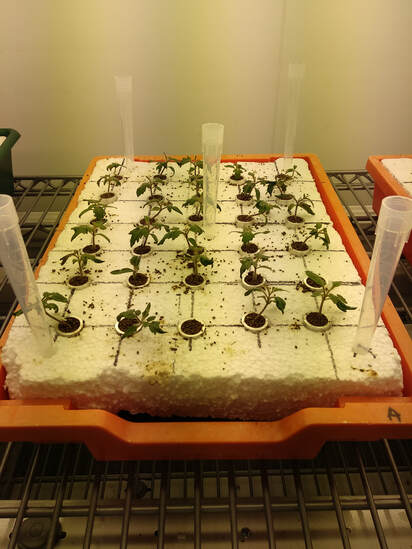 Tomato plants growing in aluminium tubes to be imaged in ISIS and Diamond (Photo credit: Xavier Portell-Canal) Tomato plants growing in aluminium tubes to be imaged in ISIS and Diamond (Photo credit: Xavier Portell-Canal) “Root microorganisms provide valuable services to plants, including drought tolerance and protection against pathogens” says Xavier, an agronomist at Cranfield University. It’s thought that plant actively recruit specific microorganisms by changing the profile of chemicals secreted by their roots in response to different stresses. Exploiting these relationships could therefore help achieve the goal of increasing agricultural production without resorting to more chemical inputs. Certain companies already offer formulations of microorganisms to apply to crops, but these have limited effectiveness since we still don’t really understand what qualities make an optimal rhizosphere. Xavier intends to investigate this, looking at both the physical properties of the soil and the characteristics of the microorganisms. “At the moment, we don’t really know what qualities allow microorganisms to reach the rhizosphere and colonise there” he says. But trying to establish this through physical experiments is challenging, since it is almost impossible to take soil samples without disturbing the plant roots and surrounding soil. Consequently, Xavier is using a modelling approach, built on techniques he formerly used to study the growth of Saccharomyces cerevisiae, the yeast used in fermentation. “Our intention is to construct a highly accurate physical model of the rhizosphere and then populate this artificially with microorganisms that have different traits, to see which ones establish most effectively” he says. “We can then use this knowledge to identify the individual species most likely to be important for a good rhizosphere”. To build a 3D model of the physical soil structure, Xavier will use sophisticated, non-destructive imaging techniques that leave plant and soil samples intact. These include X-ray and neutron imaging, both of which are based on passing a beam through the sample that is altered depending on the sample’s composition. Whilst X-rays will be used to characterise the physical architecture, neutron imaging will map the distribution of water surrounding the root. To model the movement of water and chemical species, Xavier will use a computational method called Lattice-Boltzmann modelling, which simulates the reactions that occur on heterogeneous surfaces. With so many factors, the task of integrating the data into a single model will be far from easy. “Because the rhizosphere has so much physical, chemical and biological complexity, and lots of mechanisms playing a role, it is going to be a real challenge to bring this together in a multi-parametric system” Xavier says. “For instance, even the amount of mucilage around a plant root can dramatically alter the physical environment”. Once the physical and chemical environment is constructed, the next step will be to populate it with simulated microorganisms. Individual microorganisms will be given different levels of certain traits, such as growth rates, mobility, enzyme production and metabolic rate. “Once we know the general characteristics of successful colonisers, we can use information from published databases to identify the most likely microbial species” Xavier says. Ultimately, this could allow microbiologists to select beneficial microorganisms more likely to colonise the rhizosphere and provide the intended services to the plant, boosting crop productivity. Although this goal will take time to reach, Xavier is excited by the journey since it will allow him to use some of STFC’s most impressive facilities, including the Diamond Light Source synchrotron (for X ray analysis) and the ISIS Neutron and Muon Source (for neutron imaging). “With the funding from the STFC Food Network+, I was able to develop a network of experts that work on these facilities” he says. “Through our meetings, we developed the research proposal and successfully applied for beamtime on these facilities. We intend to use these experiments to generate preliminary data that will give us a stronger case to attract further funding”. “Recently, we have really become aware that soils are central to a number of issues of great societal concern, such as climate change, environmental pollution and feeding the growing world population. I am very grateful to the STFC Food Network+ because this project has allowed me to work on such an important issue using techniques and facilities I wouldn’t have accessed otherwise” Xavier concludes.
New ways of using remote-sensing satellite data could help the banana industry prepare for and respond to threats from fungal disease and climate change
Can you imagine a world without bananas? Whether used as an on-the-go snack or baked into banana bread, bananas are one of our favourite fruits worldwide, and they are an important staple for many developing countries. But the future of banana production is under threat. Many plantations across South East Asia have already been wiped out by a lethal fungal pathogen: Fusarium wilt TR4 (also known as Panama disease). Commercial bananas have no resistance to Fusarium and there is no effective chemical treatment, hence global supply chains would be heavily affected if this disease spread across the major banana production areas in Latin America and the Caribbean. On top of this, climate change may cause some regions to become unsuitable for banana production, besides allowing new pests and diseases to spread.
There is an urgent need to prepare for these uncertainties and to assess the potential impacts on supply chains. However, bananas are under-researched compared with many other major crops. In particular, there is very little data on where bananas are currently produced. This is being addressed by BananEx, a project led by Professor Daniel Bebber (University of Exeter) through the UK Global Food Security programme. The STFC Food Network+ (SFN) has supported BananEx by providing funding for a project investigating how satellites and remote sensing technologies could be used to map banana plantations at unprecedently high resolution. “In previous work to assess the likely impacts of climate change on banana production, we didn’t have accurate information about where bananas are grown” says Dr Varun Varma (Rothamsted Research), an ecosystems services modeller and part of BananEx’s research team. “This meant we could only make very rough estimates based on assumptions, for instance, the assumption that most banana plantations are in low-lying, relatively flat areas. We need much better data in order to make more robust and targeted analyses.” Varun spotted an opportunity when he learnt that the European Space Agency (ESA) were making a wider range of their remote-sensing satellite datasets publicly available. These included earth observation images collected using synthetic aperture radar (SAR). This technology was originally developed for military purposes to produce maps at fine-scale, and has since been applied in geosciences and disaster management. More recently, it has started to be used for biological and agricultural purposes, for instance mapping crop types grown across Belgium. “We realised that SAR could be perfect for mapping banana plantations” says Varun. SAR doesn’t result in what most of us think of as a ‘satellite image’: a full-colour optical photograph produced using multispectral imaging. As Varun explains, “Instead of taking a traditional photo, SAR takes a radar image. It basically creates an image of the texture of the land surface.” In SAR, the surface is actively illuminated with radio waves. The amount of radar signal that is scattered back depends on the surface’s texture, with smooth surfaces (such as water) reflecting very little. Different crops have unique structural properties (for instance, the large, upright leaves of banana plants), which allows them to be detected and differentiated. “A particular benefit with using these datasets from ESA is that they are routinely collected as their satellites orbit the earth, so new images are made available at least every 2 weeks. Consequently, we can be sure they are up-to-date” says Varun. Another key advantage is that, unlike multispectral imaging, SAR is not sensitive to cloud cover, and so provides an uninterrupted signal of the earth’s surface over time. Despite these benefits, using SAR presented a new challenge for Varun, whose previous work mapping forests and savannahs has been mainly based on multispectral imaging. “Using SAR required a different way of thinking to understand what the data was telling us. Instead of asking ‘What is the colour of the canopy?’, we are now asking ‘What is the structure of the surface?’” Naturally, working out how to use the data and develop it into an initial mapping model involved a period of trial and error. This in itself could have posed a problem, with each image typically covering 20,000 km2 and using over a gigabyte of data. Combining multiple images to produce a map is simply far beyond the processing power of a standard desktop computer. “This is where it was a real advantage to draw on our SFN collaborators, particularly Professor Seb Oliver (University of Sussex), who helped us access the high-performance computing facilities at the STFC” says Varun. “It meant we could trial ideas quickly, see if they didn’t work and start again if necessary.” The project also partnered with CORBANA, Costa Rica's National Banana Corporation, who provided ‘on the ground’ information about where their banana plantations were located. This was used to test and refine the initial model until it achieved an accuracy of 98% at a resolution of 10 m. BananEx has since produced a preliminary map of banana plantations covering large parts of Central and South America, and the Caribbean.
Banana plantation distributions in parts of Panama, India and Colombia (credit: BananEx).
Having demonstrated the high accuracy of their model, Varun hopes that in the near future it could be developed into a continuously monitoring system. “Agricultural landscapes change very quickly, so we can’t afford to produce ‘snapshots in time’ every 8-10 years. For instance, extreme weather events can badly affect banana plantations, but we will only see how quickly they recover if we have continuous monitoring.”
“I’m very grateful to the SFN for enabling this project. It has given me the space and opportunity to explore a new kind of data for me and it has been a good example of ‘learning by doing.’ Being part of the network has also introduced me to people with very diverse backgrounds and expertise- including physicists, chemists, biologists and data scientists – who are all working together to improve food systems” Varun concludes. A project supported by the STFC Food Network+ (SFN) is breaking down the barriers between different scientific disciplines to understand how new technologies can most effectively help small holder farmers. When we consider the challenges facing small holder farmers, we usually think of environmental and physical factors, such as climate change, crop diseases, droughts and degraded land. It’s easy to see how these impact yields and productivity, and it therefore seems natural for food security interventions to focus on them. But even the most sophisticated technologies can be rendered useless if they do not take into account the wider context within which they need to work. “New technologies certainly have a role in improving food security, but we need to consider the actual day-to-day circumstances that farmers operate in if we want to see effective change” says Lisa Emberson, an ecophysiological modeller at the University of York. “For instance, a brilliant new technology that boosts yields won’t make a difference if farmers can’t access the finance to afford it, or if a health issue means they are physically unable to implement it. If we want to avoid this, we really need to engage the environmental and physical variables with social, political and economic factors.” Traditionally, these disciplines have been distinct and separate, but as part of a scoping project supported by the SFN, Lisa is starting to break these barriers down. By aligning these areas to work together more closely, the aim is to identify the most critical issues affecting productivity for different groups of farmers. Along with her colleagues*, Lisa is exploring how to combine as many different datasets as possible, to cover the whole spectrum of variables that impact small holder farmers. “By linking these datasets to a common endpoint – such as yields or nutrition – we can then use artificial intelligence techniques to understand which factor is the most important in determining the result. For some farmers, it may be the climate, but for others it could be a local governance issue.” This will ultimately allow interventions to focus on where they can be most effective. The project was born out of the 2019 SFN Sandpit Event, where Lisa met her future collaborators for the project. Realising that new advanced modelling methods could help integrate social and environmental variables, they developed a proposal with three key aims:
Having decided to focus on southern Africa, the team built up a network of partners, including the CGIAR Agricultural Research Centres, agricultural extension officers, farmers, and agricultural research institutes. These provided a wide range of local datasets, including crop yields, soil health, local incomes and government policies. Meanwhile, Lisa’s collaborators from the STFC allowed the project to access climate-related datasets collected from satellites and remote sensing methods. The challenge now is to work out how to link these different datasets together, and the best methods to extract useful information. “The main problem we have found so far is that these datasets often use very different temporal or spatial scales” says Lisa. “For instance, physical datasets such as weather patterns can be on a regional scale with good coverage and spatial and temporal resolution. In comparison, socio-economic datasets are on a much more localised, household level often with sparse coverage over limited time periods, purely due to the practical difficulties of collecting these data by survey.” Fortunately, the project’s link with the STFC enables them to access experts in artificial intelligence and machine learning methods. These techniques can help with such disparities of scale, particularly when it comes to developing and applying novel methods to scale-up socio-economic data. Progress is promising and the team have already demonstrated, for instance, that ownership of Information Communication Technology varies considerably depending on wealth, age, sex and education level. Although many efforts to improve communication between farmers focus on mobile phones, only around 59% of surveyed households owned one. This means that other outlets, particularly radio, will likely play an important role in engaging ‘hard to reach’ social groups. 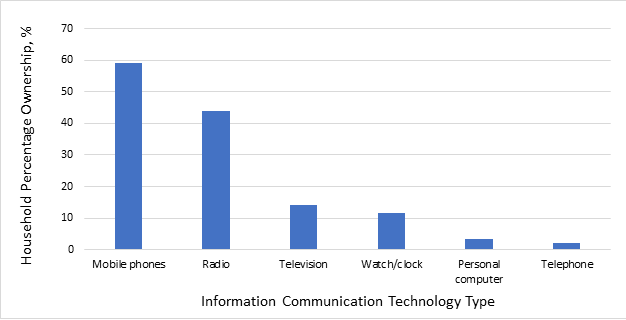 Percentage of survey respondents in Malawi, southern Africa, that own each Information Communication Technology type. The data show that mobile phones are the most commonly owned type of ICT, followed by radio. Other types of ICT are dramatically less commonly owned, with 30% less households owning a television than those that own a radio. This preliminary work has become the foundation of a full project proposal to identify how digital solutions could most effectively improve agricultural livelihoods in southern Africa, focusing on farmer’s health, women and minority groups. Potential solutions may include real-time digital data on market prices; digital financing platforms that allow farmers to secure loans; information dissemination via mobile phones to control crop diseases or digital documentation opportunities that improve land rights.
“I’ve really enjoyed working with a more diverse and interdisciplinary team to explore how environmental and physical science can work closely with social and economic science. In the real-life world that farmers experience, all these factors are integrated so it doesn’t make sense for these disciplines to work separately. Up to now, we have been good at paying lip-service to multidisciplinary working, but it hasn’t been done as effectively as it could be. Hopefully, we will set a precedent to change this” Lisa concludes. *The project team includes: Eleanor Jew, Connie O’Neill, Rob Brunt, Ibrahim Habli, Jonathan Hook (University of York); Naresh Magan (University of Cranfield); Wayne Martindale (The National Centre for Food Manufacturing); Christian Thierfelder (The International Maize and Wheat Improvement Center - CIMMYT); David Mkwambisi (Malawi University of Technology); Althea Wilkinson (Jodrell Bank); Dawn Geatches (STFC Daresbury) and Peter Allan (STFC Rutherford Appleton Laboratory). New technologies are disrupting every step of our food supply chains, from the foods we produce, to how we harvest, store, prepare and shop for it. How will these exciting trends shape perhaps the most ‘traditional’ meal – the Christmas Dinner – by 2050? Caroline Wood asked champions and members of the STFC Food Network+ (SFN) for their thoughts… For many of us, Christmas immediately conjures up pictures of a family roast dinner: turkey, goose, beef or ham. But increasing concerns about climate change and the environmental impacts of industrial animal farming (including pollution and deforestation to produce animal feed) are driving a growing trend towards alternative proteins, such as lab-grown meat. “There are really exciting things around the corner in lab-grown and fermented protein research that in 50 years may be able to produce a lab-grown turkey that tastes better than anything we have today” says Sean Peters, CEO at DryGro. But with so many hurdles to overcome, including scale-up, regulatory approval and consumer acceptance, he admits that this is likely to be some time yet. “In the short run, for many people Christmas dinner may look very similar, but instead of the ubiquitous soybean, the animals that supply their Christmas turkey or ham may be fed from more sustainable ingredients, sourced much closer to where the animals were raised.” These may include animal feeds based on insects or Lemna: a protein-rich aquatic plant. Dry Gro is currently working to develop enclosed growing units that will enable industrial-scale production of Lemna in arid regions where soybean cultivation is not possible. Even if our ingredients will still be sourced from farms for now, vastly accelerated plant and animal breeding – driven no doubt by gene-editing technologies such as CRISPR-Cas9- may already have started to alter the taste, texture and nutritional profile of our Christmas foodstuffs. “It’s likely that future plant and animal breeders will not just focus on yield but also consider nutrition, storage, and gastronomic potential” says Christian Reynolds (City, University of London). “This could see us enjoying sweeter-tasting sprouts, nutritionally-enriched spuds or even strawberries designed to grow during the UK autumn.” He also points out that the impacts of climate change will almost certainly see new food ingredients on our plates from more resilient plants. A report from Knorr and the WWF in 2019 profiled 50 ‘Foods for the Future’ that collectively have high nutrition, low environmental impacts and climate resilience. So perhaps our Christmas Meal will include climate resilient delicacies such as cacti, lotus root, sprouted chickpeas, pumpkin flowers and algae? Whatever we put on our plates, getting hold of the ingredients for our Christmas meals might become a lot easier, thanks to big data analytical tools that may help supermarkets more accurately forecast the stock levels required, leading to less empty shelves. Laura Wilkinson (Swansea University) is currently involved with a SFN project to develop models which can predict consumer behaviour through social media discussions. “The ability to capture external information and the sentiment of individual consumers via data analytics and social media may allow for more precisely estimating consumer demand, even during the hectic Christmas run-up” she and the project team say. “This could help stores to keep stock costs low, target promotions and reduce overall waste. We hope these tools could also help direct unsold produce to communities that are in need of them, for instance via charities.” But it may be that we don’t shop in advance for our Christmas Dinner – in fact, we might not even decide what to have until Christmas morning itself. The increasing sophistication of wearable health trackers and our ability to mine biomimetic information may lead to all our meals being individually optimised on the day to our needs. “Based on the current use and generation of data by apps and devices, I think the next step will be that we use this information to inform our decisions about food and overall lifestyles” says Ximena Schmidt, STFC Food Network Champion and a life cycle sustainability expert (Brunel University). “So, based on both health information (such as weight and blood pressure) and data gathered about our lifestyle (for instance food preferences, favourite recipes, geolocation), these devices will propose the most suitable Christmas Dinner for each of us.” Perhaps it could even be nutritionally optimised to reduce any alcohol-fuelled damage from Christmas Eve parties the night before? John Vandore, STFC Food Network and Business Development at Harwell Campus, agrees although he believes these devices will eventually progress to an implant. By that time, the stress of preparing the Christmas meal may well be a thing of the past. “For urban populations, I suspect there will be turbocharged online ordering and delivery, no doubt with drone deliveries playing a part. In high rise residential housing, this may be augmented with vertical farms making fresh vegetables available at the push of a button on each floor” he says. Once we’ve assembled our ingredients, we may well cook our Christmas meals using different methods to now. A study led by Christian Reynolds found that depending on the food product, the greenhouse gas (GHG) emissions from cooking can be decreased by up to 16-fold by using more efficient methods. “Ovens are the least sustainable common cooking appliance, since they typically require long cooking times and high energy demands” he says. Electric grills are a better option since these only consume half the energy, but this may be a hard sell for those particularly attached to the memories and aromas associated with ‘a proper roast dinner’. Nevertheless, as smart energy-readers make us acutely aware of our energy consumption around the home, it’s likely we’ll move away from boiling and steaming foods on the stovetop: a highly-inefficient method due to energy losses and the long time required to reach the cooking temperature. “In contract, microwaving can reduce GHG emissions by 41-78%” says Christian. Electronic pressure cookers may also come in vogue: since these substantially shorten the cooking time, these are a highly efficient way to cook meat, pulses, potatoes and vegetables. By 2050, Christmas Dinner may not just be eaten on Earth: will human colonists on the moon (and maybe even Mars) also be tucking into a special meal on the 25 December? Stephen Ringler, CEO & Founder of the Space Store and Spacetime Development is optimistic: “There are promising experiments being conducted to see if we can turn Martian and lunar surface material into soil safe to grow food. Another alternative would be to us hydroponics, growing plants using nutrient-rich solutions without soil.” As for the non-plant components of the meal, he is hopeful that space travel will have advanced enough by then to allow regular shipments from Earth.
Wishing you all a very peaceful Christmas and New Year from the STFC Food Network+ ! The STFC Food Network+ (SFN) has helped launch a visionary project which aims to use systems analysis, digital platforms and space technologies to revolutionise agri-food supply chains in India. The moment a crop is harvested, it begins to spoil. This isn’t too much of a problem in modern systems where they are quickly whisked to consumers, arriving fresh and intact. But in developing nations lacking such infrastructure, huge quantities of perishable food are lost between farmers and consumers. For these regions, simply producing more food won’t help solve food insecurity unless these supply chain issues are fixed. Food loss occurs for a variety of reasons, including lack of cold storage, poor road networks and challenging climates. Developing communities are also typically made up of isolated pockets of farmers that are poorly connected to the rest of the supply chain, making it difficult to match supply with demand. With so many interconnected factors and problems, it is challenging to identify where effective interventions can be introduced. This is the aim of TRAnsforming Cold Food Chains in INdia through Space ScIence and TechNologies (TRANSSITioN). Using a systems-wide approach, this will identify relevant cutting-edge and indigenous technologies for digitising agriculture production, connecting farmers to supply chains, reducing food loss and managing food surplus. The project is a collaboration involving the University of Sheffield, the Science and Technology Facilities Council (STFC) and a range of partners from industry, NGOs, logistics providers and farming organisations. The SFN played a crucial role in the project’s launch by funding the pilot phase through a Scoping Grant. This involved a stakeholder workshop in India which brought together farmers, producers, distributors and retailers to discuss the key problems affecting their industries. Based on these discussions, the team successfully secured funding for a full-scale project proposal from the UK Government’s Global Challenge Research Fund and the STFC. The different work packages include: Identifying key leverage points for change: Using food systems concepts and methods, this will determine the obstacles, risks and opportunities for supply chain transformation in India. This will be coupled with life cycle analysis (LCA) to understand the wider impacts of possible interventions, including energy, carbon emissions, water and toxins. Digitising agriculture and connecting farmers: This will investigate the most effective digital platforms to connect farmers to supply chains. In addition, it will explore how Internet of Things (IoT) technologies and remote sensors can link farmers to data (such as soil health, local weather and crop diseases) that can help them increase productivity, farm more sustainably and be more climate resilient. Reducing losses and maximising value: Drawing on expertise from STFC’s RAL Space facility, this will investigate how existing, indigenous methods can be integrated with advanced capabilities (including space technologies such as cryogenics and thermal modelling) to increase the shelf life of fresh produce. It will also investigate new materials and methods for improving thermal insulation on farm, during transportation and storage. New business models and policies to support rural livelihoods: This will engage stakeholders and communities to co-design new public-private partnerships and funding models, including microfinance. The need for a holistic approach
“There is a clear opportunity to have a big impact on reducing agri-food loss throughout supply chains in India. But any changes have to work in the context of the existing system, be economically feasible and not harm farmers or the environment. That’s why we are using a holistic approach, rather than looking at things in isolation” says Seyed M. Ebrahimi (University of Sheffield). With a diverse background covering supply chain management, LCA, finance, banking, and computer software, Seyed seems aptly qualified for such a multidisciplinary challenge. So far, he has been involved with helping to map different end-to-end supply chain configurations for tomato and mint, which has involved visiting around 50 different farms across southern India. He is now combining this with data from the pilot workshop into a complete LCA and socio-economic evaluation of proposed interventions. Such extensive mapping work is crucial to avoid unintended consequences, and can also lead to counterintuitive findings as Seyed explains. “A key contributor to tomato spoilage is fluctuations in temperature. Our preliminary data suggest that if tomato crops are only put in cold storage at the end of the chain at the retailer, it may actually be worse than not using cold storage at all.” Ultimately, TRANSSITioN aims to introduce economically feasible technologies that enable cold storage throughout the chain, whilst meeting social and environmental priorities. Yet this work has identified other changes that could be made more quickly, such as on-farm grading technologies that reduce handling at downstream distribution centres, prolonging product life. The power of partnerships Linking up small scale farmers – many of whom still rely on handwritten notes – with the latest technologies won’t be easy, but TRANSSITioN is giving itself the best chance of success by partnering with government bodies, the Centre for Sustainable Agriculture, the Society for Elimination of Rural Poverty and retail giants such as Amazon India. Being part of the SFN is also proving instrumental in helping the team access expertise in advanced technologies being developed at the following STFC facilities: RAL Space, Cryox, ASTeC, and IBM Research at Hartree Centre. “This is a very exciting project – the more you delve into it, the more you realise how challenging it is to introduce changes that will really work in these systems. A lot of these capabilities – such as cryogenics and thermal engineering – have only been proven in aviation and formula one facing; they have never been tested in the agri-food sector. That is why it is so important to work in partnership” Seyed concludes. Shellfish are a highly nutritious and a sustainable protein source, and provide livelihoods for people in numerous rural regions all across the globe. The UK alone imports over £700 million of shrimp each year. Yet shrimp farming is currently highly inefficient: globally, nearly 40% of shrimp are lost due to reasons that include extreme weather, disease and supply chain issues. Such wastage results in reduced profits for farmers, increased prices for consumers and greater environmental impacts. A project launched by the STFC Food Network+ (SFN) is working to make the Indonesian shrimp farming industry more efficient and sustainable, using digital technology and new business models. Mapping the challenges “There are many new technologies that could really benefit small scale shrimp farmers in Indonesia” says Miying Yang (University of Exeter). “But to work out the best changes to introduce, we first needed to understand the different stakeholder needs and the realities of the industry that these interventions would have to work in.” To explore the challenges facing the shrimp farming industry and the potential for digital solutions, Miying and her colleagues* conducted a feasibility study, funded by an SFN Scoping Project award. The team travelled to Indonesia in July 2019 to host a workshop which brought together stakeholders from across the entire shrimp value chain. This included shrimp farmers, distributors, farming associations, retailers and government officials. The format of the event was structured on a framework Miying developed during her PhD research on developing methods to analyse and assess sustainability metrics from life cycle and multi-stakeholder perspectives. “The atmosphere was outstanding – much better than I expected it would be. We even ended up being featured in the local newspaper!” says Miying. Thanks to support from interpreters from a local university, the research team could involve all the participants, including those who spoke no English, and present the aims of the project before the discussions began. 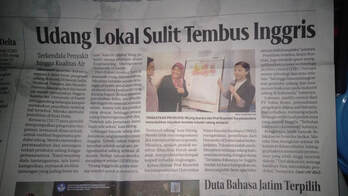 The research team were even featured in the local newspaper! (Credit: Miying Yang) The research team were even featured in the local newspaper! (Credit: Miying Yang) Seventy different industry challenges were identified, which the team grouped into twelve themes. The stakeholders were then asked to rank these themes according to their importance and how feasible they felt it would be to tackle them. “The final results indicated that the most impactful issues to target included fluctuating water conditions, disease and cannibalism, where the shrimp feed off each other” Miying says. This information allowed the team to develop a proposal and secure a £50,000 grant from the Engineering and Physical Sciences Research Council’s Internet of Food Things Network+ to launch a full-scale project to tackle these issues. Predictive assistance in aquaculture management Drawing on the key challenges identified by the pilot project, Miying and her colleagues are focusing on an internet of things (IoT)-enabled system to automatically monitor different qualities of the water in shrimp farms. The team are working on a prototype model where off-the-shelf water sensors collect real-time data on parameters such as dissolved oxygen, salinity and water temperatures. The data is then automatically sent to an IoT Cloud database. These datasets will allow big data analytics to develop predictive algorithms for how conditions may change in the future. The ultimate aim is to integrate this with a web-based platform or smartphone app that can send alerts directly to individual farmers. “This predictive assistance will allow farmers to make decisions on a scientific basis, rather than relying on their instincts” says Miying. “For instance, such an app could send notifications about when to feed the shrimp since this needs to be finely balanced. If they are fed too much, this wastes feed, but if they are fed too little, they start to eat each other.” Besides helping farmers to take preventative action to reduce death and disease, this could also help them to minimise their environmental impacts through reducing inputs of feed and chemicals. Digitally-enabled business models and transparent supply chains Meanwhile, the team are also considering how to tackle the inefficiencies within the shrimp supply chain that reduce the overall quality and add to the cost of the product for the consumer. “Farmers, distributors and retailers across the Indonesian shrimp supply chain are not working collaboratively or sharing data. But there would be real benefits to all if they could be linked in a fully safe, traceable system using digital technologies” says Miying. Fully digitalised supply chains could allow demands to be communicated to suppliers and distributors more quickly, reducing the time shrimp are kept in storage. Greater transparency could also reduce the cost of assessing shrimp to check it meets food standards requirements – which can be an expensive burden for small-scale farmers. According to Miying, introducing such a system is not limited by technology, but by more fundamental barriers including governance, data trust, and stakeholders’ willingness to participate. “People need to see the tangible benefits of sharing their data for this to work. We are looking for funding opportunities to work on building a technological prototype for a fully traceable supply chain.” ************ Having worked mainly in manufacturing in the past, the project has immersed Miying into a totally new world for her in the food sector. “It has been really exciting for me to apply my skills to solve different problems and find innovations that help industries to be more sustainable and circular” she says. But having grown up in Zhejiang, the coast of South East China, she has always had a love of seafood: “Especially fried rice with shrimp!” You can learn more about the project through a short video at https://vimeo.com/368769846 *The project team includes Dr Miying Yang (University of Exeter), Dr Martino Luis (University of Exeter), Dr Jens Jensen (STFC), Professor Peter Ball (University of York) and Rakesh Nayak (LeanSig Ltd; STFC Food Network+ Liaison) The world has a protein problem – and one that will only get worse. Our over-reliance on soybean for animal feed is unsustainable and threatened by climate change. A project supported by the STFC Food Network+ (SFN) could have the solution: an unremarkable-looking plant you have probably never even heard of. The growing problem Whether we are vegans, vegetarians or carnivores, we all need protein. An astonishingly high proportion of our protein ultimately originates from a single crop – soybean. A key component of global livestock feeds, soybean is also used for many meat- and dairy-alternative products (such as plant-based burgers and soya milk). But this dependence is starting to cause serious problems as Sean Peters, CEO of start-up DryGro, explains: “Global meat consumption is expected to grow significantly in the years ahead, which puts pressure on soybean expansion in Brazil and Argentina. Climate change could also damage the productivity of agricultural land, causing yields to reduce.” Currently, 80% of soybean is grown in just three countries – the USA, Argentina and Brazil. This means it is far removed from communities in developing countries who then rely on expensive imports. “What we urgently need is a climate-proof protein source that can be grown in arid regions, closer to animal production communities” Sean says. Introducing Lemna Could a small, unremarkable-looking water plant be the answer? Meet Lemna; a genus of floating aquatic plants that resemble tiny lily pads. Also known as ‘water lentil’, Lemna has a protein content remarkably similar to soybean. It also grows astonishingly fast, forming thick, green blankets on the surface of water. Farmers across Asia and Africa have harvested these for hundreds of years to use as a protein ingredient. But scaling this up for industrial levels of production is hindered by Lemna’s aquatic nature. DryGro has taken on this challenge by developing enclosed growing units designed to be set up in many places around the world. These units maintain optimal growing conditions through an environmental management system, and build on recent advances in vertical farming techniques. But can this tiny duckweed really take on the monopoly of soybean? Sean certainly believes it can: “Per hectare, Lemna can produce eight times as much protein as soybean” he says. “This means that at industrial scale, DryGro’s growing facilities would be much more land efficient than soybean production.” And since this can be harvested every few days, Lemna offers a significantly more stable supply than the soybean industry, which only has two major harvests each year: once for the southern hemisphere and once for the northern hemisphere. Ultimately, Lemna-based animal feeds could act as an alternative to all soybean feeds for livestock, including chickens, pigs and certain farmed fish. Researchers from the Wrocław University of Technology, Poland, even found that feeding Lemna to chickens improves the quality of their eggs, with the authors concluding that Lemna could serve as a cheaper alternative to inorganic dietary additives [A].
Opening up new markets Lemna may be grown on ponds, but overall it uses 98% less water per tonne of product than soybean, because the water is recycled within the growing units. This makes Lemna production particularly suitable for arid regions, including land not currently used for agriculture. Lemna could therefore open up industrial-scale protein production in the eastern hemisphere, including Europe, Africa and Asia, and help avoid deforestation. This would be a particular benefit for countries such as Kenya, where practically all the soybean used in animal feed is imported due to a lack of local production. “Because the soybean value chain in Kenya is very long, farmers end up paying a higher price for a product that is typically inferior, as it can be tampered with along the way” says Sean. “This keeps the farmers in a constant poverty trap. But if we can produce animal feed locally, this could completely restructure the value chain.” The power of partnerships But before Lemna can go mainstream, it needs to be a reliable, consistent product. Thanks to a scoping award from SFN, DryGro has partnered with the Open University on a project to characterise the quality of Lemna grown under different temperatures and fertiliser concentrations. This will use the Open University’s spectroscopic equipment, which characterises the biochemical properties of samples based on how they interact with light. “The network has been incredibly supportive in fostering our collaboration with partners that have expertise in these techniques. As a start-up, this really lowered the barriers for us to access such high-spec laboratory equipment” Sean says. He adds that the SFN offered a much nimbler approach for them to access funding than many other avenues: “It was so refreshing not to have to undergo a typical, behemoth grant application process that eats up your soul. Instead, we were able to work out our proposal with just a few meetings and get it submitted within a week.” Whilst excited about DryGro’s potential, Sean clearly sees their work as part of a much wider movement towards more sustainable food systems, one that depends upon the multi-disciplinary work that SFN helps to facilitate. “It’s evident that what got us through the last century won’t get us through the next – the only solution is to research tomorrow’s technologies today. Groups such as the Knowledge Transfer Network and SFN make that happen. Advancements in research only benefit the rest of humanity if they become products, services or techniques that people can actually use. It’s through collaborative work like this that we can make it happen” Sean concludes. [A] Witkowska, Z., Saeid, A., Chojnacka, K., Dobrzanski, Z., Górecki, H., Michalak, I., Korczynski, M. and Opalinski, S., 2012. New biological dietary feed supplement for laying hens with microelements based on duckweed (Lemna minor). American Journal of Agricultural and Biological Sciences, 7(4), pp.482-493. Whether drizzled over porridge or used to treat a sore throat, honey is one of our most cherished food products. In the UK, honey consumption is steadily rising but competition from cheaper imports and barriers to entering the ‘premium’ honey market could stop UK producers from benefitting. A project funded by the STFC Food Network+ (SFN) is helping to address this by applying a pioneering spectroscopic technique for a new use in the honey industry Honey samples collected by Maria and her team for the study (Image credit: Maria Anastasiadi). The UK consumes over 40,000 tonnes of honey per year, however most of the honey we see on supermarket shelves is imported from abroad where it is cheaper to produce. But a growing interest in ‘monofloral honeys’ – where the bees collect pollen from a single type of flower – could open up a new market for UK beekeepers. These honeys have characteristic flavours and textures, besides enhanced health benefits including high concentrations of antioxidant compounds. Consequently, monofloral honeys can command premium prices. Heather honey, for instance, can retail for up to £14 for a 340g jar. But it is currently difficult for beekeepers to enter this lucrative market since there is no quick and easy way for them to prove that their honey is genuinely monofloral. “The only option is to send samples to a dedicated laboratory to analyse the pollen content, which is time consuming and expensive” says bioinformatician Dr Maria Anastasiadi (Cranfield University, UK). Recently, Maria’s work has focused on exploring how spectroscopic technologies (where matter interacts with electromagnetic radiation) can be used within the food industry. “I realised that the honey industry really needs an easy-to-use diagnostic tool that can instantly tell whether a honey is monofloral or multifloral in origin. Through the grant from the SFN, we tested three candidate techniques to do this” she says. The power of spectroscopy Maria was particularly interested in Spatially Offset Raman Spectroscopy (SORS), a recently developed technique that shows great promise for a wide range of analytical applications. Raman spectroscopy analyses the composition of a sample by measuring the degree by which monochromatic light is scattered by the sample’s constituent molecules. Representative photonics spectra for different types of honey: heather (left), borage (middle), multifloral rapeseed (right) (Image credit: Maria Anastasiadi). In SORS, the light source is offset, allowing it to penetrate deeper without being obscured by the overlying surface material. So far, SORS has been demonstrated capable of detecting explosive materials inside containers and impure pharmaceuticals within sealed blister packs; it is also being investigated for a tool in breast cancer diagnosis. Food industry applications of SORS have so far been limited, and it until now it had never been tested on honey products. During the 2019 SFN Sandpit event, Maria met Professor Pavel Matousek, one of the inventors of the SORS technique at the Science and Technology Facilities Council’s Rutherford Appleton Laboratory. “We were really lucky to meet Pavel, as he is an established leader in this field and agreed to become a co-investigator on this proposal” she says.
Promising results To start with, Maria and Pavel collected over fifty different honey samples, including monofloral heather and borage honeys from across the UK and multifloral honeys. Alongside SORS, the group also tested two more established spectroscopic techniques; Attenuated Total Reflection Fourier Transform Infrared and fluorescence spectroscopy. The spectroscopic profiles produced by the different samples were then fed into a machine learning algorithm to train a model to automatically classify the floral origin of unknown samples. “When we introduced samples that the model had not encountered before, we found that both SORS and fluorescence could predict the floral type with over 90% accuracy” says Maria. “What is particularly exciting is that this is a non-invasive technique that doesn’t even need the sample container to be opened.” Protecting the farmers With this success, the team wondered whether spectroscopy could help solve another problem – an ongoing battle against adulterated products. Typically, this occurs when pure honey is diluted with cheap high-fructose corn syrup or other sugars and occurs mostly outside the UK. Easy-cost efficient tools to establish authenticity could help British bee farmers safeguard the quality of their product and increase its value. Maria and her team diluted pure heather honey with known amounts of corn syrup and again used the spectroscopic profiles in a machine learning model. “The prediction models developed using fluorescence and SORS were able to identify adulterated samples with over 80% accuracy” says Maria. “If the model was expanded to include more samples, we believe that this could be enhanced to distinguish adulteration even at very small scales.” The end goal With the positive results from this project, Maria is now looking to develop these techniques into a simple diagnostic device for the honey industry. Potentially, this could both help honey producers to authenticate their premium monofloral honeys and give customs officials and honey suppliers a tool to spot fraudulent products in transit. “It is really important that the end-product is something that is easy to use and can instantly give the user an answer they understand. We are now working closely with stakeholders in the UK honey industry and recently organised a webinar to discuss how we can develop a platform for honey testing based on portable sensors.” The benefits of a network “I am at an early stage in my academic career, so this has been a valuable opportunity to develop a project of my own. The SFN has been extremely helpful throughout in addressing my questions and offering constant support” Maria says. She is also grateful to the Bee Farmers’ Association who put them in touch with beekeepers across the UK to help them source honey samples. Maria hopes that, in time, the fruits of this project will bring long-term benefits to their industry: “One of the things that really inspired me to do this project was my worry about the decline of honey bees and other pollinators. I hope that the results of this project can help promote British-produced honey and generate more interest in amateur beekeeping” she concludes. Curious to know more about SORS? Check out our previous blog post ‘Caught in the act’ about an SFN-project that explored whether SORS could help detect adulterated fruit juices. In our last blog post, we told the story of how the STFC Food Network+ (SFN) didn’t let a global pandemic stop the most recent Sandpit from going ahead by transitioning the whole event online for the first time. Although this gave a very different experience to the usual, in-person format, this clearly didn’t impact the quality of the proposals which resulted from the discussions. Here we feature the winning projects for each theme, which were decided by democratic vote to receive £10K each in funding. Theme 1: Sustainable production at uncertain times – smart beehive monitoring Bees and other pollinators play a crucial role in agriculture: approximately 70% of our food crops depend on them. Yet pollinators are suffering from a perfect storm of challenges, including diseases, climate change, air pollution and toxic insecticides. For the SFN Sandpit’s winning theme 1 project, Paulette Elliott (Huduma) and her colleagues will be developing a prototype sensor to monitor honey bee hives in real time. “There are already various sensors on the market, for instance to monitor the hive’s humidity or to count the bees as they enter and leave the hive” Paulette says. “Our aim is to use machine learning and artificial intelligence to analyse the data from these existing sensors to see where there are repeated anomalies or trends that can identify specific problems.” This knowledge will then be applied to build a proof-of-concept sensor for a particular issue. In contrast to existing sensors that currently use Wi-Fi or mobile data technologies, the new sensor will be linked with satellite technology, extending its capabilities further. For instance, earth observation remote sensing information could help beekeepers understand if their hives are in the optimum location, either to avoid air pollution hotspots or to access the bee’s preferred source of pollen. Besides involving experts across a broad range of fields, the project is also committed to engaging with end-users. As Managing Director of Huduma, Paulette brings significant experience of working with start-ups and SMEs to develop successful business models for emerging technologies, particularly those based on Internet of Things and autonomous systems. Her colleagues and Co-Investigators include high-performance computing specialists, experts in mathematical modelling from STFC Hartree, University of Warwick, The Open University, UKRI-STFC and the company OPTIfarm, which currently provides real-time monitoring systems for poultry farms. “We intend to collaborate with beekeepers’ networks across the country, including both hobbyists and commercial” says Paulette. “Rather than assuming what the most important issues are, we want to work in partnership with them to identify the most critical factors for bee colony health.” Theme 2: Resilient food supply chains at uncertain times – Better indicators to spot food fraud Ever since food began being traded as a commodity, fraudsters have tried to make a quick profit at the customer’s expense. Fraud costs the UK food economy approximately £11 billion each year, but this may be only the tip of the iceberg since fraud is frequently underreported. Besides the financial repercussions, this can have serious health consequences, for example by exposing consumers unknowingly to allergens. The Sandpit’s Theme 2 winning project aims to combat this by equipping authorities with more powerful tools to identify cases of food fraud as they happen. “It’s currently a huge challenge to detect food fraud. Often, agencies only become aware if it causes ill health or if they are alerted by an insider” says project leader Edward Smart (University of Portsmouth). To identify potential indicators of food fraud, the project will bring together a broad range of food-related databases, including import/export databases, global temperature data and commodity prices. This will be combined with a historical database of known incidences of food fraud. Data science experts at the STFC will then use powerful computational methods to hunt for patterns and trends that could have predicted these events. “As an example, if the price of a foodstuff such as oats suddenly decreases in value, this could be a sign that the market is becoming flooded with a poor quality or fraudulent product” says Edward. The ability to link such indicators to fraudulent activities, particularly during shock events such as the coronavirus lockdown, could help policy makers develop strategies to reduce the flow of fraudulent goods, such as more targeted border checks. “The Sandpit came at an opportune time since my colleague Lisa Jack and I had just completed a project on calculating the true cost of food fraud” says Edward. “At the Sandpit we were introduced to food researchers from the University of Central Lancashire, Brunel University and Fera Science Ltd. Food fraud was a common interest for all parties and as we started talking, it became clear that data science techniques could be a powerful tool in finding more effective indicators of food fraud. Theme 3: Nutritional security & consumer behaviour at uncertain times - Intelligent Data Analytics to Understand Food Consumer Practice during Food Shocks “COVID-19 and the associated lockdowns clearly demonstrated how consumer behaviour can ‘shock’ food systems, resulting in essential items becoming scarce” says Laura Wilkinson (Swansea University). “For food systems to be resilient against future shocks- for instance, as a result of further lockdowns, Brexit or climate change – it is vital that decision makers can anticipate how consumers will react.” In their winning project, Laura and her colleagues will look for trends in consumer behaviour using the huge volume of online commentary that the pandemic has generated, which can act as a ‘window’ into why people behaved as they did. To convert this heterogenous mix of images, videos and text into meaningful information, Laura and her colleagues will use an approach that combines citizen science and intelligent data analytics. “Our first step will be to categorise the data and describe the sentiment of posts: is the person laughing about the shortage of a particular food, or are they genuinely panicked about it?” The project will explore data from various sources, including Twitter, Facebook, YouTube, Instagram and Deliveroo reviews. “Using a citizen science platform (Zooniverse), we will invite members of the public to help us categorise images and text to form a ‘training dataset’. Then we will apply deep learning techniques to this dataset to teach a computer to perform the process automatically” says Laura. The end result will be a preliminary model that will be able to forecast specific events (such as flour running out of stock) on the basis of the text and images that individuals post online (e.g. comments about flour). Similar to the other winning proposals, the project brings together a diverse range of disciplines, involving psychologists, nutritionists, economists, computer scientists and data analysts. “We also benefit from being able to access STFC’s high-performance computing facilities and experience in running citizen science projects” Laura says. If successful, she hopes that the group will be able to access additional funding to both scale-up the model and engage retailers, so that they can additional information, such as sales data, to better understand the relationship between consumer sentiment and their buying behaviours. Look out for our future blog posts which will give updates on the progress of the projects funded in our previous Sandpit events and funding calls |
AuthorSeptember 2022 - Caroline Wood, Freelance Science Writer Archives
April 2024
Categories |
- Home
- SFN+ 5th Annual Conference Resources
-
Other Resources
- Webinars
- Forum
-
Resources
>
- SFN+ 5th Annual Conference
- OMM Policy Report
- ‘Multi-Stakeholder International One Day Workshop on Organic Agri-Food Value Chains for Net Zero’ Report
- SFN 2050 UK Net Zero Food report
- Sustainable Cold Food Chain Booklet
- Food Sensing Technologies for Safe and Nutritious Food
- Sustainable urban and vertical farming
- About the SFN
- Blog
- Expert Working Groups
- Funding
- Impact
- Projects
- News and Events
- Join/Contact Us

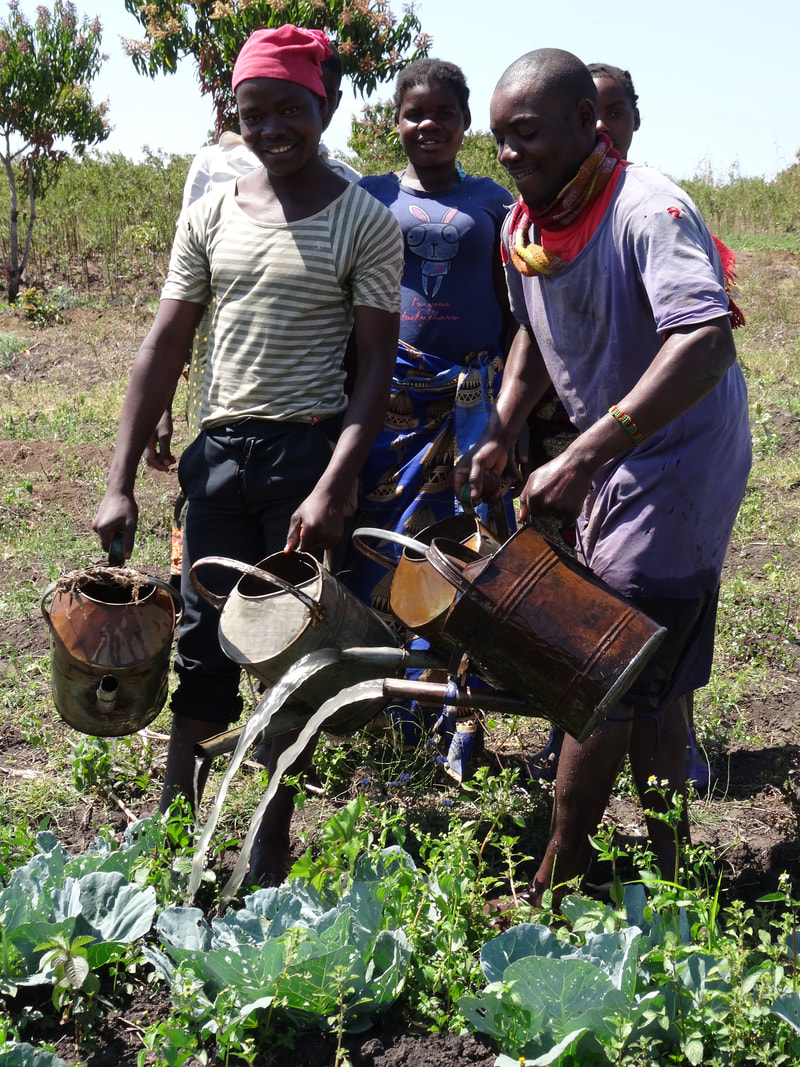


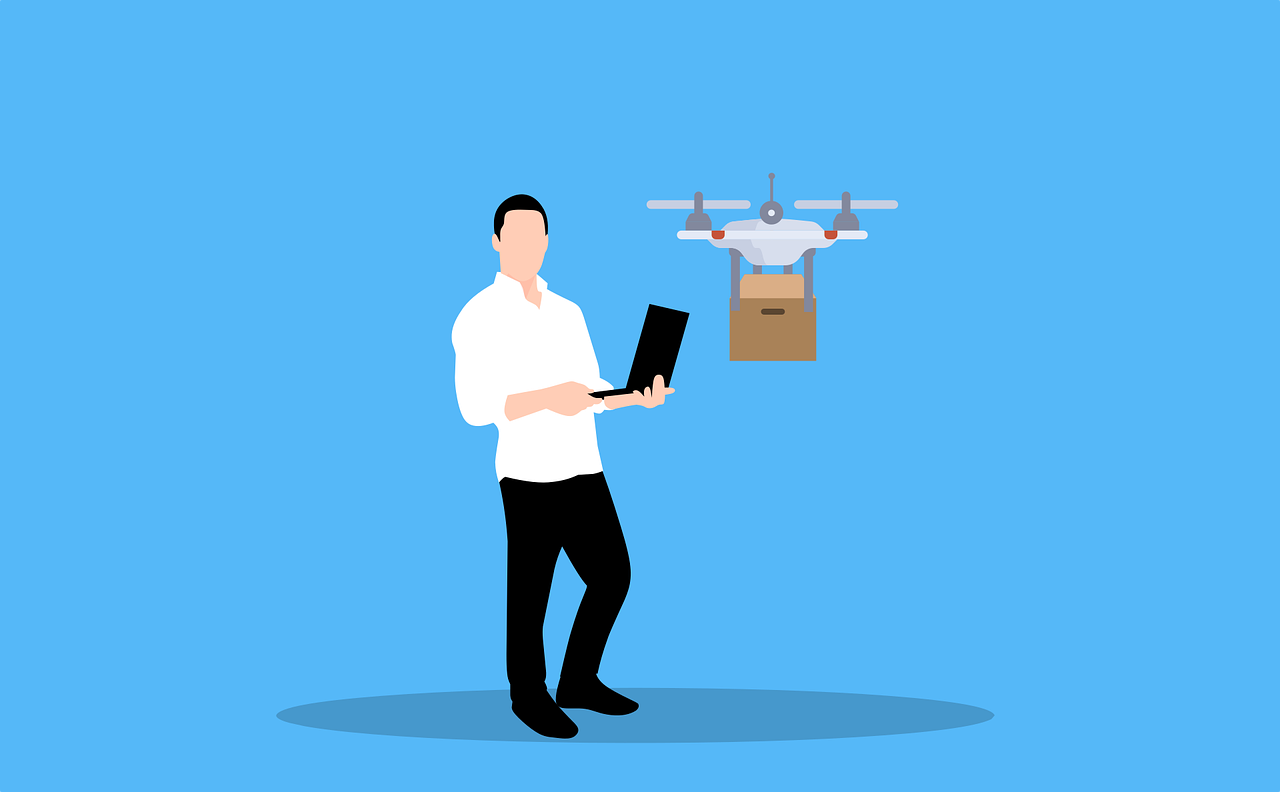

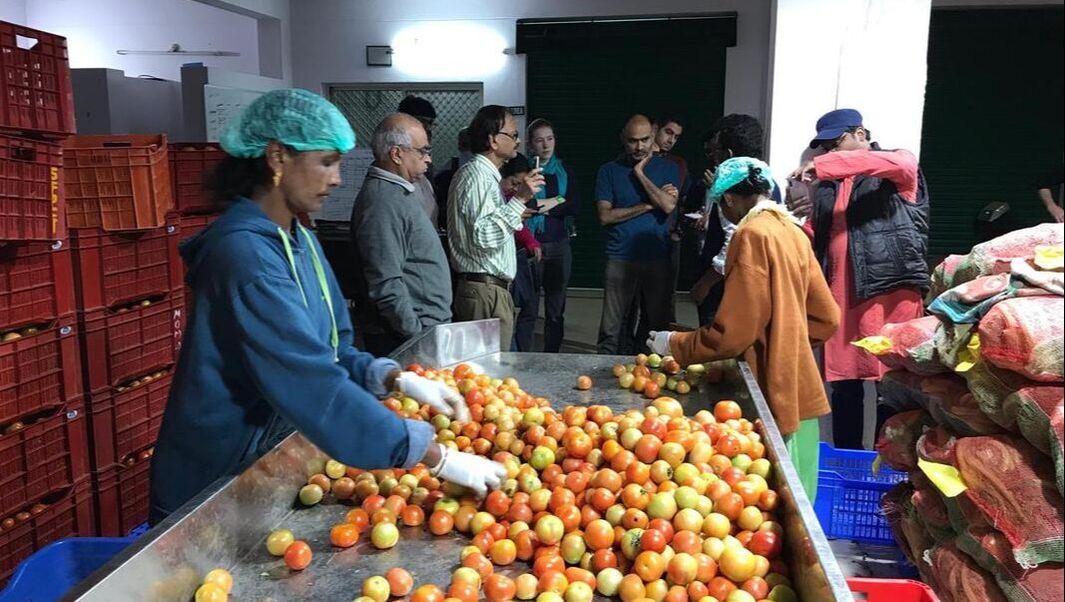
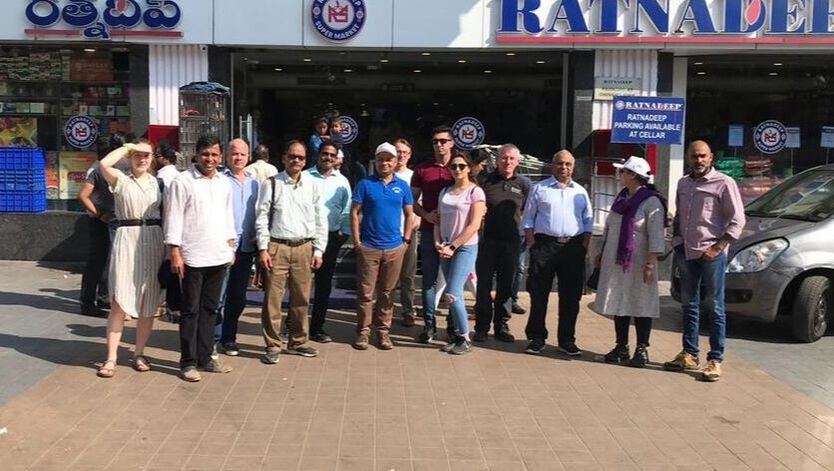
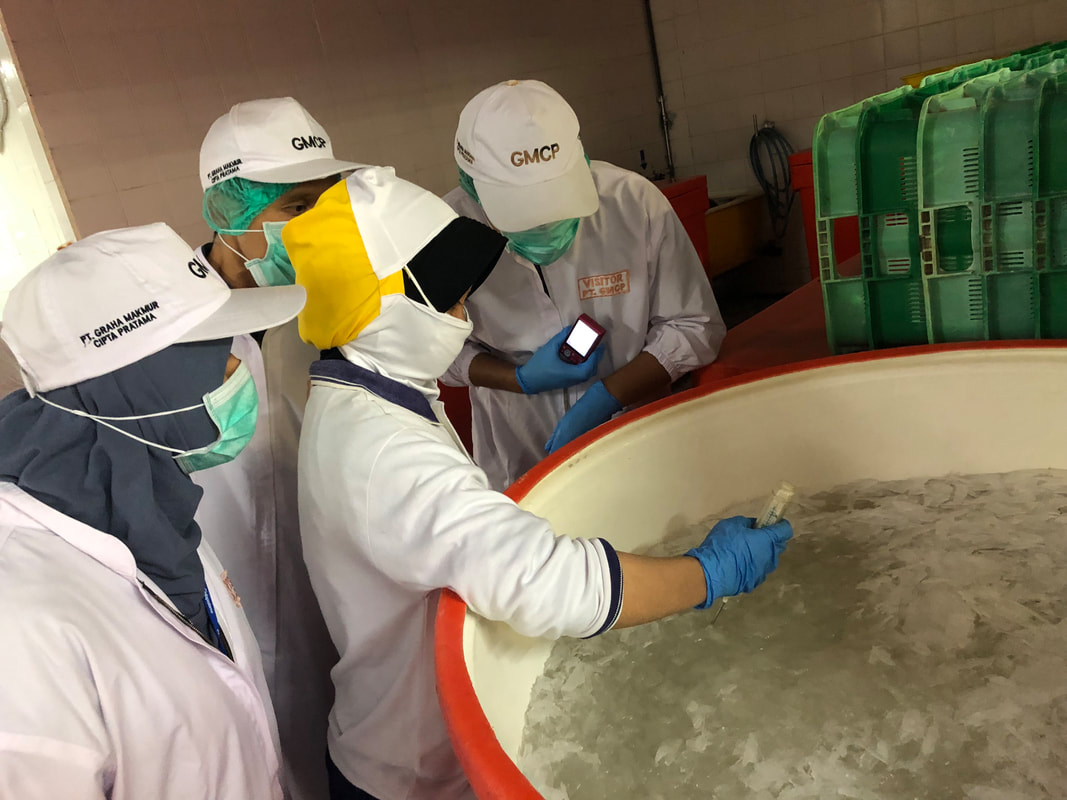
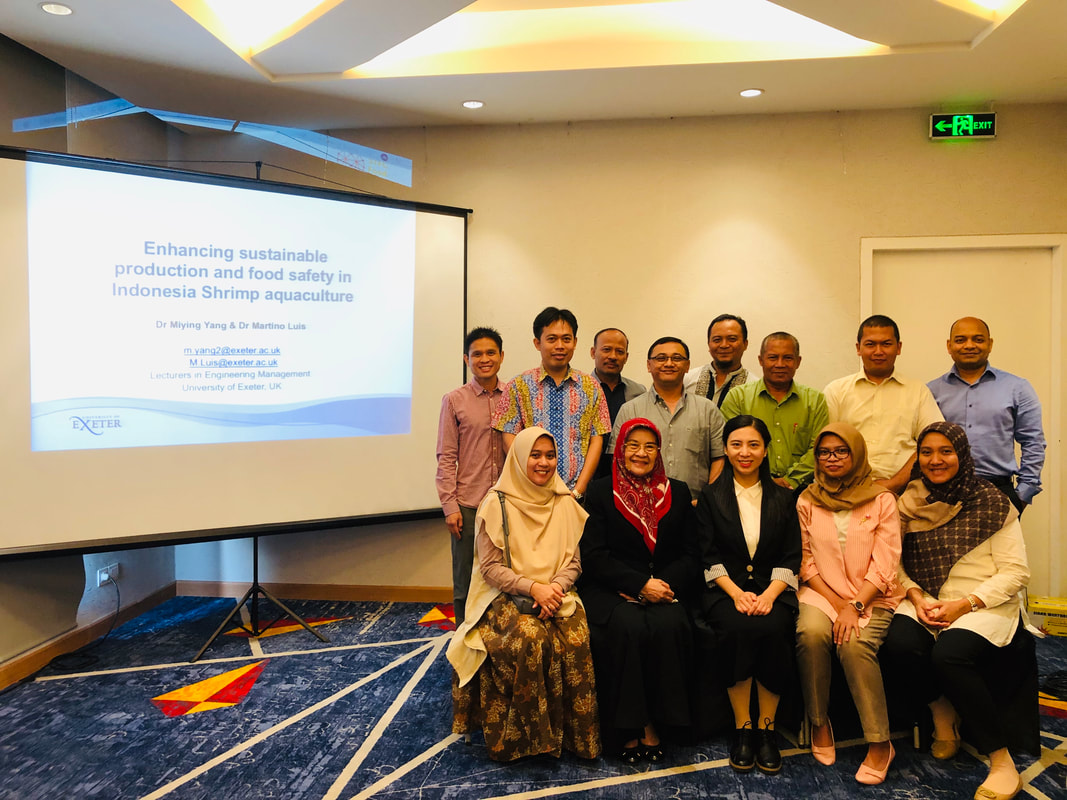
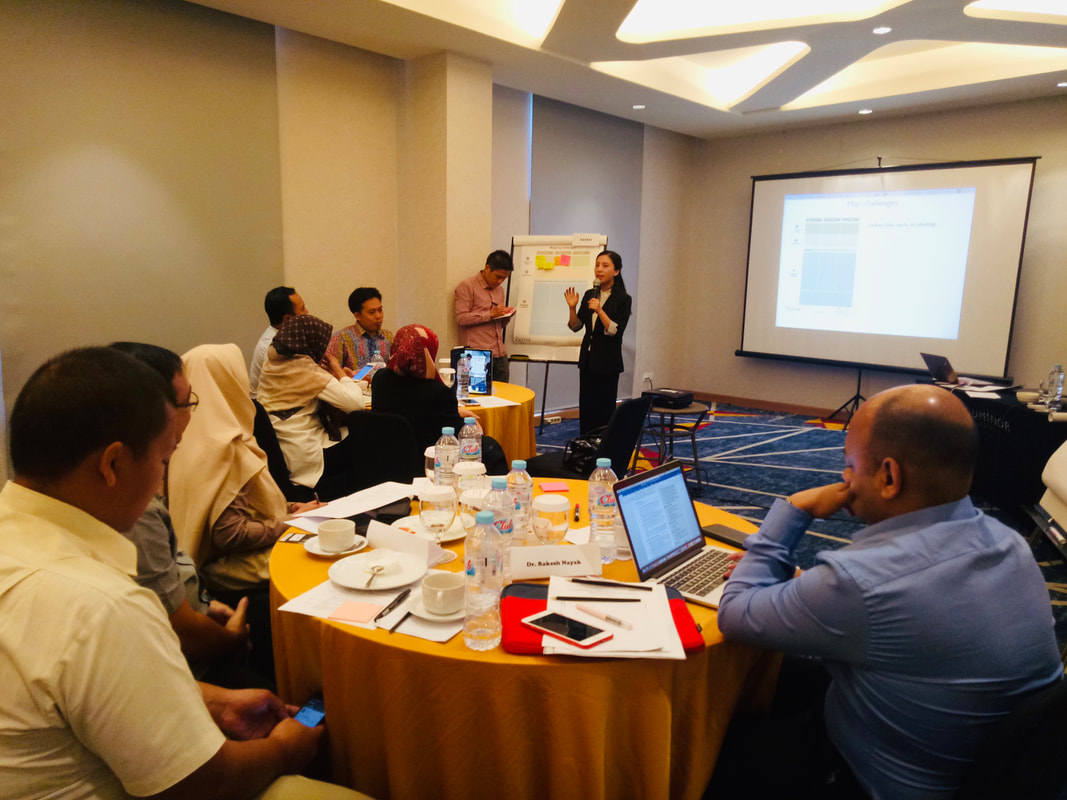
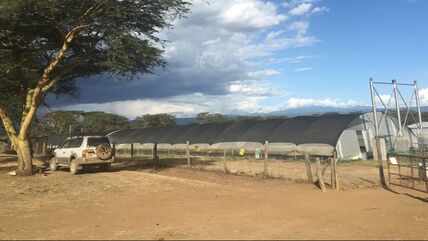
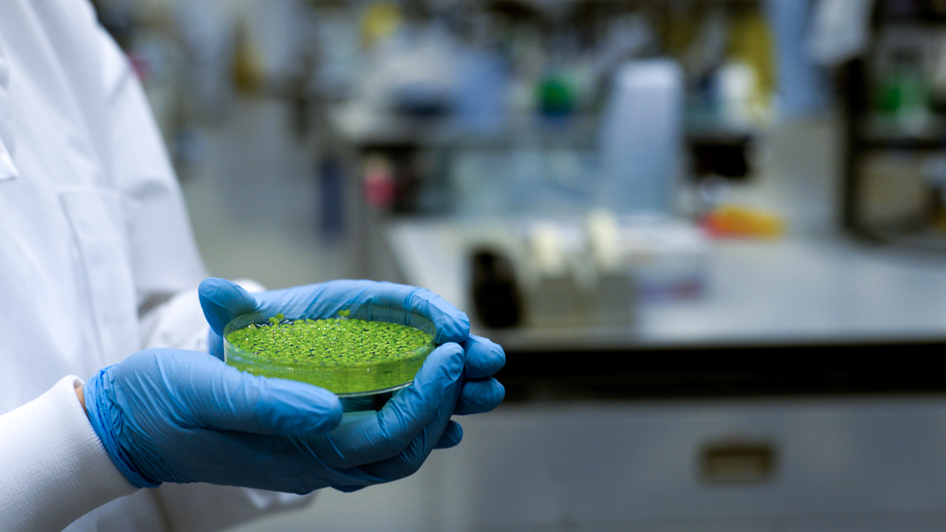
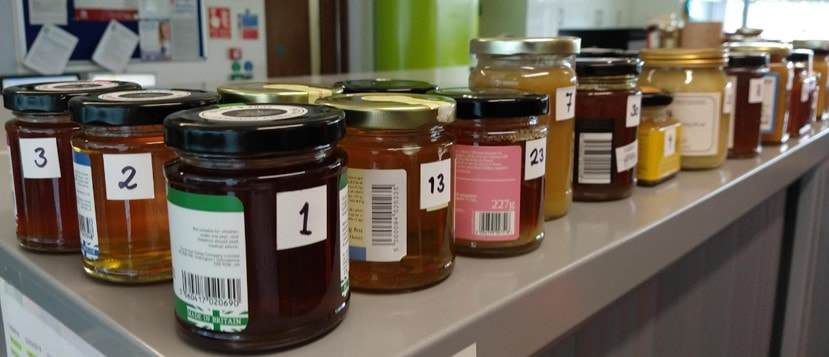

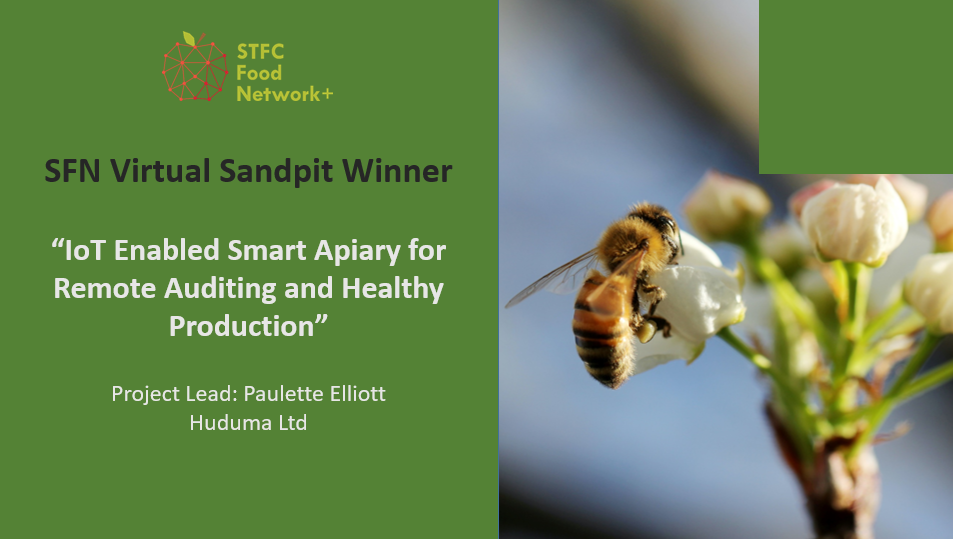

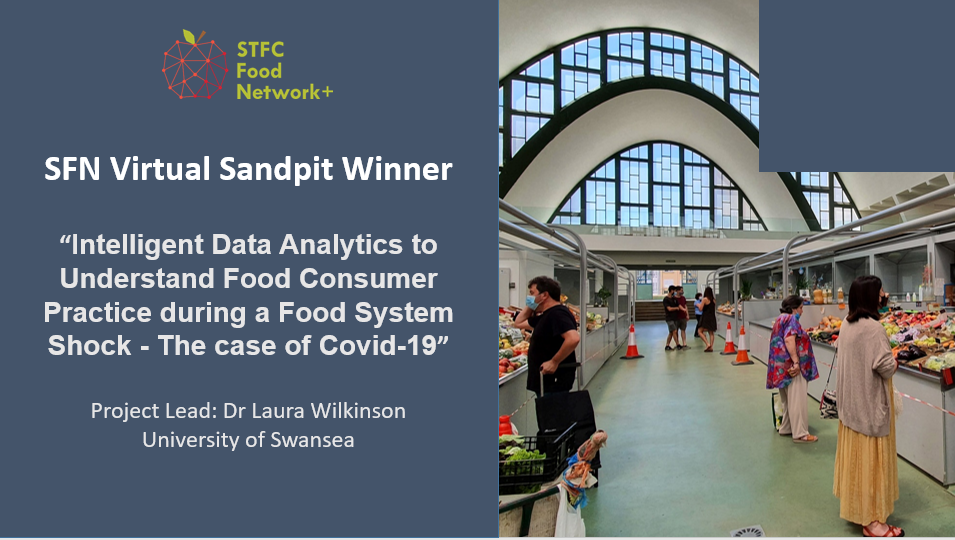
 RSS Feed
RSS Feed


